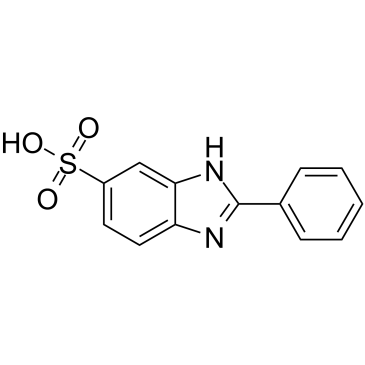2-Phenylbenzimidazole-5-sulfonic acid

2-Phenylbenzimidazole-5-sulfonic acid structure
|
Common Name | 2-Phenylbenzimidazole-5-sulfonic acid | ||
|---|---|---|---|---|
| CAS Number | 27503-81-7 | Molecular Weight | 274.295 | |
| Density | 1.5±0.1 g/cm3 | Boiling Point | N/A | |
| Molecular Formula | C13H10N2O3S | Melting Point | 300 °C | |
| MSDS | Chinese USA | Flash Point | >100ºC | |
|
Sodium montmorillonite/amine-containing drugs complexes: new insights on intercalated drugs arrangement into layered carrier material.
PLoS ONE 10 , e0121110, (2015) Layered drug delivery carriers are current targets of nanotechnology studies since they are able to accommodate pharmacologically active substances and are effective at modulating drug release. Sodium montmorillonite (Na-MMT) is a clay that has suitable prope... |
|
|
Adverse reactions to sunscreen agents: epidemiology, responsible irritants and allergens, clinical characteristics, and management.
Dermatitis 25(6) , 289-326, (2014) Sunscreen is a key component in the preventive measures recommended by dermatologists and public health campaigns aimed at reducing sunburn, early skin aging, and skin cancer. To maximize compliance, adverse reactions to sunscreens should be minimized. Althou... |
|
|
Removal of micropollutants from aerobically treated grey water via ozone and activated carbon.
Water Res. 45(9) , 2887-96, (2011) Ozonation and adsorption onto activated carbon were tested for the removal micropollutants of personal care products from aerobically treated grey water. MilliQ water spiked with micropollutants (100-1600 μgL(-1)) was ozonated at a dosing rate of 1.22. In 45 ... |
|
|
Occurrence of xenobiotics in gray water and removal in three biological treatment systems.
Environ. Sci. Technol. 44(17) , 6835-42, (2010) Eighteen selected xenobiotics related to personal care and household chemicals (UV-filters, fragrances, preservatives, biocides, surfactants) were measured in gray water from 32 houses and in effluents of three different biological treatment systems (aerobic,... |
|
|
Application of a biomimetic sensor based on iron phthalocyanine chloride: 4-methylbenzylidene-camphor detection. Boni AC, et al.
J. Braz. Chem. Soc. 21(7) , 1377-83, (2010)
|